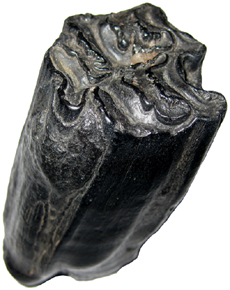
 |
 |
Science
Olympiad
| Mammals | |
The Swedish scientist Carlous Linnaeus (1707-1778) coined the term Mammalia (Latin mamma, “breast”) in 1758 to group vertebrates whose young are nourished by their mother’s milk. A visit to the zoo will quickly reveal that mammals are very diverse and that they are the dominant large vertebrates for most modern ecosystems. Today there are over 5,000 living species of mammals; however, the fossil record reveals the fact that many different species of mammals have existed at different times in ancient ecosystems. Mammals & Dinosaurs Mammals first appear at about the same time as Dinosaurs in the Triassic period. Dinosaurs evolved into many forms and came to dominate many Mesozoic ecosystems. During the entire reign of the dinosaurs, mammals remained small never getting any bigger than a cat. The evolutionary biologist Stephen J. Gould (1988) commented, “Mammals were relatively rare…They lived under the foot of dinosaurs, in the nooks and crannies of a dinosaur world.” Most dinosaurs did not survive the extinction event at the end of the Cretaceous although; a small group would give rise to the birds. Many niches were opened up to the survivors of this extinction event. Mammals, in particular, possessed important characteristics that would allow them to evolve into many forms that could occupy these empty niches. Mammals have been so successful during the Cenozoic era that it is often referred to as the “age of mammals”. What are some of the characteristics that have made mammals successful? Characteristics of Mammals Mammals nourish their young with milk secreted from mammary glands on the mother’s chest. The milk is a source of water, proteins, carbohydrates, fat, and minerals. Mammary glands allow the mother to feed its young without leaving the nest or burrow. The young is given an easily digestible source of food. While feeding on the milk the young also benefits from the parents presence, which provides warmth and protection. Most other vertebrates lay eggs and the hatchlings are often independent at birth and must survive on their own. Mammals, like birds, are “warm-blooded”, that is they maintain a constant body temperature through the rapid metabolism of food. A constant body temperature allows mammals to be active at night or day, live in cold environments, and sustain activities that require high levels of energy like running long distances and flying. Maintaining a constant body temperature by fueling a high metabolism comes at a cost, it requires on average 10 times as much food as a “cold-blooded” organism of comparable size. Mammals have many adaptations for maintaining a constant body temperature, one of which is insulating hair. Most mammals have live birth, that is, the young are born alive after developing inside the mother. Most other vertebrates lay eggs although; live birth has evolved independently many times in fish, amphibians, reptiles, and mammals, but not in birds (Cowen, 2005, p220). Live birth does have some advantages over laying eggs. A fetus that grows inside the mother has an unlimited supply of water, oxygen, and nutrients. Waste can be easily removed. The fetus is protected from predation and disease. The fetus is easily kept at a constant temperature. A fetus is more flexible and can squeeze through the birth canal easier than a shelled egg. Although the newborn is not independent it can be nourished by the mammary glands of the mother. Mammals have fewer offspring, but invest heavily in their young through extended parental care. Mammals have a prolonged period of development during which time the parents protect and care for their young. The young learn to care for themselves under the tutelage of their parents. Using parental care for a small number of offspring increases the chances that they will survive. Many other vertebrates do not exhibit parental care and increase the chances that some of their young will survive by producing large numbers of offspring. The above characteristics are not always easy to determine using fossil evidence. Fortunately, mammals also share many features that are more easily determined from fossil skeletal structures. Mammals have an enlarged outer folding of the brain called the neocortex. Enhanced senses of vision, hearing, and smell along with a more active lifestyle require a more sophisticated brain. Fossil skulls can be used to make inferences about the brain. Mammals have three inner ear bones, the malleus, incus, and stapes, which transmit sound from the eardrum to the oval window. The malleus and incus are remnants of the bones in the lower jaw of primitive amniotes. The three inner ear bones increase the ability of mammals to hear high frequency sounds like the buzz of insects. This would have been important for early mammals that ate mostly insects. Mammals have a single bone making up the lower jaw with a powerful masseter muscle, which improves chewing efficiency. The primitive amniotes and reptiles have a lower jaw made of multiple bones. Mammals have two sets of teeth, milk and permanent. Mammal teeth are specialized into incisors, canines, premolars, and molars. The upper and lower molars of mammal teeth fit together well making them efficient at processing food. The molars of mammals have branched roots that help to secure them in the jaw; losing a permanent tooth is a serious hazard. Many other vertebrates, like the reptiles, have teeth that all look pretty much the same and are constantly replaced during their lifetime. A reptile may have a mixture of older and younger teeth in their jaw that do not meet precisely. Mammal teeth are so specialized that you can use them to determine their diet and even use them for classification. Teeth are important for studying mammal evolution because they are the most common mammal fossil. Monotreme Mammals Living mammals are divided into egg-laying mammals, pouched mammals, and placental mammals. Monotremes are egg-laying mammals and are represented by the duck-billed platypus from Australia and the echidna of Australia and New Guinea. Monotreme young develop within a protective shelled egg. The eggs are kept inside the mother’s body and nourished for a short period of time before they are laid. After the eggs are laid the female incubates them with the warmth of her body. Monotremes have an egg tooth that helps them break through their shell. Monotremes do not possess nipples, so they do not suckle their young. Instead, the young must lap up the milk as it is secreted from the mother’s mammary glands. Monotremes are the most primitive living mammal. Like the monotremes primitive mammals probably laid eggs and had poor thermoregulation. The Monotreme fossil record is scant and dates back to the Cretaceous. Marsupial Mammals Pouched mammals are known as marsupials. Today, most marsupial species live in Australia, which include the familiar koalas and kangaroos. North America has one marsupial, the opossum. South America is home to many species of opossums. Marsupial embryos are nourished inside the females’ body for a short time, but do not attach to the uterine wall. Marsupials are born underdeveloped, blind and very small. Newborn marsupials use their front legs to crawl into the mother’s pouch or marsupium where they attach to a nipple and complete their development. The marsupial fossil record dates back to the Mid-Cretaceous of North America. Cretaceous marsupials of North America were numerous and diverse, but remained small. During the Paleocene South American marsupials evolved into small insectivores, omnivores, and medium to large carnivorous forms with lifestyles like dogs, cats, and bears. Australian marsupials first appear in the Eocene. Australian marsupials of the Early Cenozoic evolved without competition from placental mammals and, unlike South America, their adaptive radiation included the evolution of middle to large herbivores as well as carnivores (Kemp, 2005, p. 208). However, as in South America convergent evolution resulted in Australian marsupials with body forms and lifestyles similar to placental mammals on other continents. Marsupial equivalents of rodents, wolves, tapirs, anteaters, and cats are easily recognized. Australian marsupials flourished and did not experience significant competition from placental mammals until aborigines arrived during the Pleistocene 40,000 years ago. Europeans introduced more invasive placental mammals during the 1780’s. Today, habitat destruction and competition from invasive species endanger Australia’s marsupial populations. Placental Mammals More than 95% of all living mammals are placentals. The embryos of placental mammals become embedded in the wall of the uterus. An organ called the placenta grows and connects the embryo to the uterine wall. The circulatory system of the developing embryo and mother are not directly connected; however, the exchange of nutrients and waste does occur through the placental tissues. The embryo is not limited by a fixed amount of food from a yolk and it is protected from the mother’s immune system, so it can develop within the womb for a longer period of time. The increased gestation permits the formation of a complex brain and nervous system. The fossil record of placental mammals dates back to the Early Cretaceous. Placental mammals in North America, Europe and Asia underwent a great adaptive radiation during the Paleocene. Most of mammalian orders that flourished during this time would become extinct. However, a few mammals that evolved during the Paleocene represent modern orders, like flying lemurs, bats, primates, odd-toed ungulates, and rodents. Representatives of all other modern orders of placental mammals appear by the early Eocene (Benton, 2005, p. 333). If you would like to learn more about mammal evolution, click on our articles below. |
|
The
2016 Science Olympiad Fossil List includes the following
genera under the class Mammalia (Mammals): Basilosaurus, Mammuthus (Mammoth),
Mammut (Mastodon), Equus, Smilodon, Megacerops, Mesohippus, and Homo
neanderthalensis. |
|
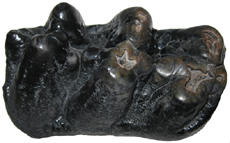 Gomphotherium Molar Rhynchotherium sp. Miocene-Pliocene Hawthorne Formation ACE River Basin Colleton County, South Carolina 11 cm long x 7 cm wide |
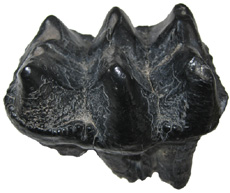 Mastodon Molar Mammut americanum Pleistocene Age ACE River Basin Colleton County, South Carolina 9.5 cm long x 6.5 cm wide |
 Mammoth Molar Mammuthus primigenius Pleistocene River Rhine, Worms Germany 13 cm long x 7 cm wide |
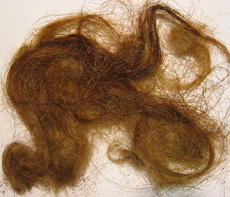 Mammoth Hair Mammuthus primigenius Pleistocene Taimyr, Siberia Russia |
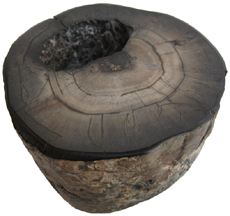 Mammoth Tusk Section Mammuthus sp. Unkown Location 7 cm diameter x 4 cm tall |
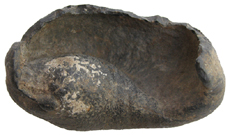 Whale Ear Bone Tympanic Bulla Miocene-Pliocene Florida 10 cm long x 6 cm wide |
|
|
Bibliography |
|
Benton, M.J. (2005). Vertebrate Palaeontology [3rd edition]. Main: Blackwell Publishing. Cowen, R. (2005). History of Life [4th edition]. Massachusetts: Blackwell Publishing Kemp, T.S. (2005). The Origin and Evolution of Mammals. New York: Oxford University Press. Gould, S.J. (1988). The Infinite Voyage: The Great Dinosaur Hunt. Stamford, CT: Vestron Video. |
|











